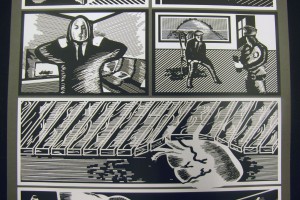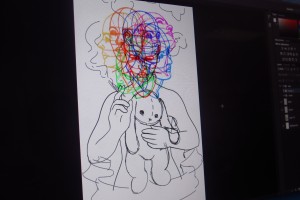New Broward College Program Wants To Train Young Artists And Designers

John O'Connor / StateImpact Florida
A storyboard created by Claudia Morell, a student in Broward College's Visual Arts and Design Academy.
A new program at Broward College has just eight students and seeks to train the next generation of South Florida artists and designers.
The school hopes to earn a national certification for the Visual Arts and Design Academy this spring – becoming the first community college in the South to have that.
Florida’s higher education system has put a focus on training workers for health care and other high-demand fields in recent years. And lawmakers have encouraged school districts to start career-training programs.
But the National Endowment for the Arts estimates the arts contribute $500 billion to the nation’s economy each year. And leaders of the Broward College program argue the arts and technology are tied together.
“People don’t realize the relationship, frequently, between science and art,” said Broward College art professor Leo Stitsky. “If we do away with pure science there would be no computer. If we do away with art there would be no Apple.”
Stitsky says most of the students in the Visual Arts and Design Academy are just developing their artistic voice. The students must apply and go through a jury process before they are admitted to the program.
Many students are like Josh Cartwright. He showed talent, but said he didn’t think of studying art or design until a high school teacher recommended the program.
“When I was graduating high school I wasn’t really into art yet,” Cartwright said. “I knew I could draw and do, like, small projects.”
During a recent class, Stitsky and Cartwright were checking out black and white illustrations of the great white whale – Moby Dick.
Cartwright likes to work in black and white. So Stitsky showed him Rockwell Kent’s 1930 pen and ink drawings for Herman Melville’s novel. Without knowing their work, Cartwright has developed a style similar to Kent and Lynd Ward, who made black and white prints from woodcuts.
“That’s kind of what I wanted to do for my self portrait,” Cartwright said.
“Yeah? For your self portrait?” Stitsky replied. “I like that one. That mood. That negative space.”
Cartwright has clearly found a style. The class’ current assignment is to create a psychological self-portrait. Cartwright’s is silhouetted in stark black and white.

John O'Connor / StateImpact Florida
Some panels from Josh Cartwright's black and white storyboard of "The Tell-Tale Heart."
For a previous assignment, he created a storyboard of Edgar Allen Poe’s “The Tell-Tale Heart” that resembles a graphic novel.
“I noticed with his stories it was kind of this intense…moment where you’re just sucked into the story,” he said. “So I wanted to use the black so it can create a very dark moody kind of atmosphere. But use the white so it’s an extreme contrast with the people that’s in it.”
Now Cartwright is interested in creating user interfaces and apps for phones, tablets or computers.
That’s the type of relationship with art and design that’s supposed to develop in this classroom.
The Visual Arts and Design Academy is a school within a school. Broward College already had plenty of students working on two-year art degrees, most of them for graphic design.
But the college wanted to create a more rigorous program with more of an emphasis on individual attention, where professors have more time and space to teach and mentor students. And it’s harder to get in to.
The goal is students complete the two-year program and then head to the best fine arts schools in the country.
“In some ways we’re hoping to emulate, to some degree, what New World School of the Arts does in Miami,” Stitsky said.
The rigor starts with entry into the program. Students have to make it through a jury, which reviews and asks them questions about their work.
“They have to learn to talk about their work,” Stitsky said, “to be conceptual. To be articulate. To be professional about presentation.”
At the end of the year, students must go through the jury process again. Monica Mendez said the jury forced her to think about what she’s trying to say.
“It was really nerve-wracking last year,” Mendez said. “You show up and you’re alone in a room and you’re there with your work.”
She didn’t second-guess her work, Mendez said, but she did think about ways she could have changed things.
Mendez’ psychological self-portrait incorporates multiple heads, religious iconography and a childhood doll.
Another student, Claudia Morell, created a small likeness of herself battling a larger, monstrous version.
The clear message?
“You’re your own worst enemy,” Morell said of her inspiration.
Monica Mendez says she loves being one of just eight students.
“We all come check on each other,” she said. “We all talk about if I like what you’re doing, or maybe you could try it like this.”
Mendez says, after she graduates, she’s thinking about doing art therapy with kids.
